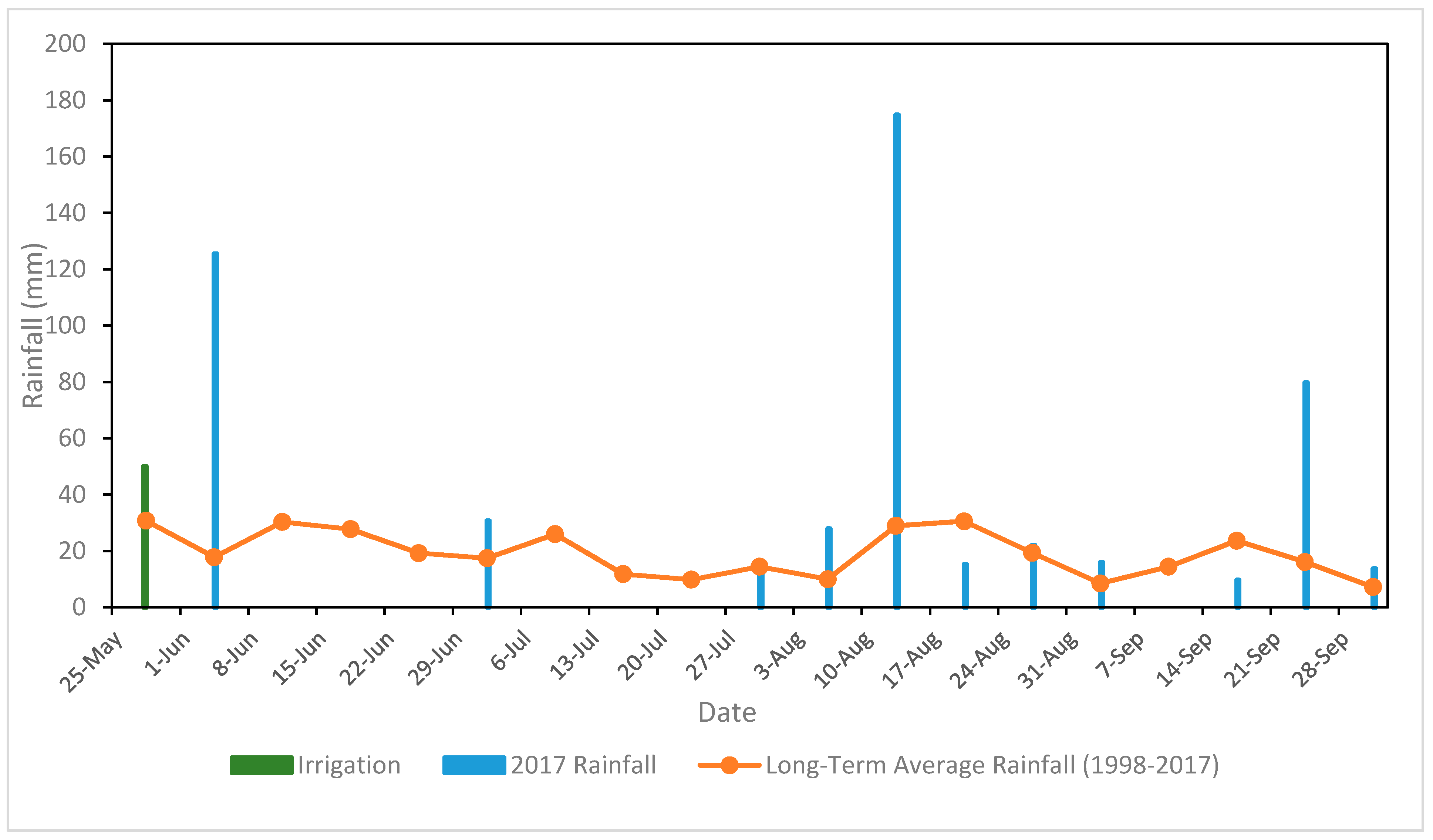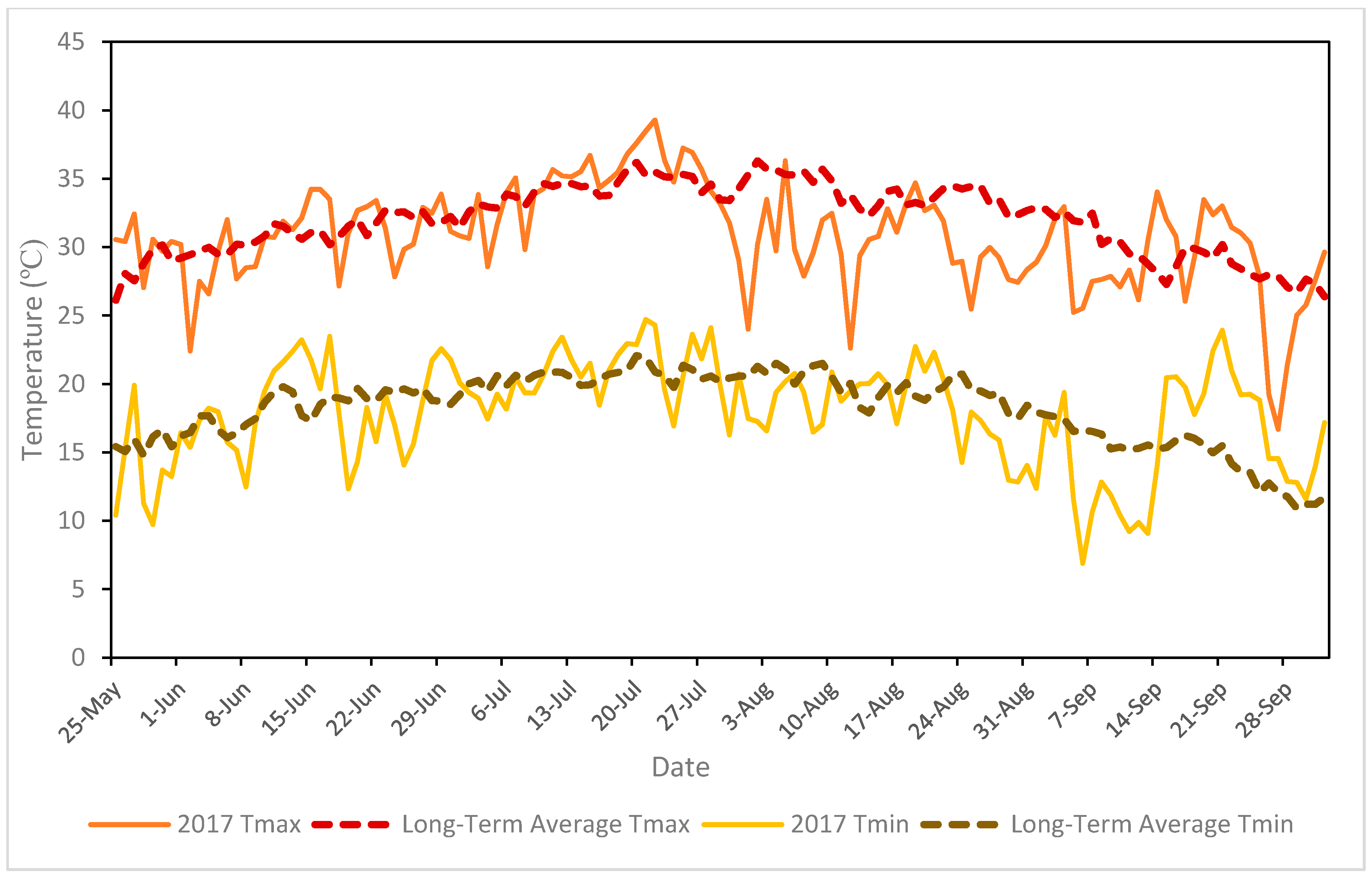Adaptability and Forage Characterization of Finger Millet Accessions in U.S. Southern Great Plains
Abstract
:1. Introduction
2. Materials and Methods
3. Results and Discussion
3.1. Adaptability
3.2. Canopy Height
3.3. Grain Yield
3.4. Forage Yield
3.5. Nutritive Value of Forage
4. Conclusions
Author Contributions
Acknowledgments
Conflicts of Interest
Disclaimer
References
- United States Department of Agriculture. National Agricultural Statistics Service. 2017. Available online: https://www.nass.usda.gov/.
- Decker, J.E.; Epplin, F.M.; Morley, D.L.; Peeper, T.F. Economics of five wheat production systems with no-till and conventional tillage. Agron. J. 2009, 101, 364–372. [Google Scholar] [CrossRef]
- Edwards, J.T.; Carver, B.F.; Horn, G.W.; Payton, M.E. Impact of dual-purpose management on wheat grain yield. Crop Sci. 2011, 51, 2181–2185. [Google Scholar] [CrossRef]
- Northup, B.K.; Rao, S.C. Green manure and forage potential of lablab in the US southern Plains. Agron. J. 2015, 107, 1113–1118. [Google Scholar] [CrossRef]
- Patrignani, A.; Lollato, R.P.; Ochsner, T.E.; Godsey, C.B.; Edwards, J.T. Yield gap and production gap of rainfed winter wheat in the southern Great Plains. Agron. J. 2014, 106, 1329–1339. [Google Scholar] [CrossRef]
- Kelley, K.W.; Sweeney, D.W. Long-term Crop Rotation and Tillage Affects Wheat and Double-crop Soybean and Selected Soil Properties. Crop Manag. 2010, 9, 1. [Google Scholar] [CrossRef]
- Phillips, W.A.; Coleman, S.A. Productivity and economic return of three warm-season grass stocker systems of the southern Great Plains. J. Prod. Agric. 1995, 8, 334–339. [Google Scholar] [CrossRef]
- Fieser, B.G.; Horn, G.W.; Edwards, J.T.; Krenzer, J.E.G. Timing of grazing termination in dual-purpose winter wheat enterprises. Prof. Anim. Sci. 2006, 22, 210–216. [Google Scholar]
- Baath, G.S.; Northup, B.K.; Rocateli, A.C.; Gowda, P.H.; Neel, J.P.S. Forage potential of summer annual grain legumes in the southern great plains. Agron. J. 2018, in press. [Google Scholar]
- Baath, G.S.; Northup, B.K.; Gowda, P.H.; Turner, K.E.; Rocateli, A.C. Mothbean: A potential summer crop for the Southern Great Plains. Am. J. Plant Sci. 2018, 9, 1391–1402. [Google Scholar] [CrossRef]
- Rao, S.C.; Northup, B.K. Capabilities of four novel warm-season legumes in the southern Great Plains: Biomass and forage quality. Crop Sci. 2009, 49, 1096–1102. [Google Scholar] [CrossRef]
- Rao, S.C.; Northup, B.K. Pigeon pea potential for summer grazing in the southern Great Plains. Agron. J. 2012, 104, 199–203. [Google Scholar] [CrossRef]
- Rao, S.C.; Northup, B.K. Biomass production and quality of Indian-origin forage Guar in Southern Great Plains. Agron. J. 2013, 105, 945–950. [Google Scholar] [CrossRef]
- Butler, T.J.; Muir, J.P. Perspective on forage legume systems for tallgrass and mixed-grass prairies of the southern Great Plains of Texas and Oklahoma. Crop Sci. 2012, 52, 1971–1979. [Google Scholar] [CrossRef]
- Northup, B.K.; Rao, S.C. Effects of legume green manures on non-grain biomass of continuous wheat systems. Agron J. 2016, 108, 1011–1108. [Google Scholar] [CrossRef]
- Rao, S.C.; Northup, B.K.; Phillips, W.A.; Mayeux, H.S. Interseeding novel cool-season annual legumes to improve bermudagrass paddocks. Crop Sci. 2007, 47, 168–173. [Google Scholar] [CrossRef]
- Upadhyaya, H.D.; Sarma, N.D.R.K.; Ravishankar, C.R.; Albrecht, T.; Narasimhudu, Y.; Singh, S.K.; Wanyera, N. Developing a mini-core collection in finger millet using multilocation data. Crop Sci. 2010, 50, 1924–1931. [Google Scholar] [CrossRef]
- Joshi, M. Textbook of Field Crops; PHI Learning Private Limited: Delhi, India, 2015; pp. 75–84. [Google Scholar]
- Irrigation. 2006. Available online: http://www.ikisan.com/irrigation.html (accessed on 9 September 2018).
- Satish, L.; Rathinapriya, P.; Rency, A.S.; Ceasar, S.A.; Prathibha, M.; Pandian, S.; Ramesh, M. Effect of salinity stress on finger millet (Eleusine coracana (L.) Gaertn): Histochemical and morphological analysis of coleoptile and coleorhizae. Flora 2016, 222, 111–120. [Google Scholar] [CrossRef]
- Singh, P.; Raghuvanshi, R.S. Finger millet for food and nutritional security. Afr. J. Food Sci. 2012, 6, 77–84. [Google Scholar]
- Shobana, S.; Krishnaswamy, K.; Sudha, V.; Malleshi, N.G.; Anjana, R.M.; Palaniappan, L.; Mohan, V. Finger millet (Ragi, Eleusine coracana L.): A review of its nutritional properties, processing, and plausible health benefits. Adv. Food Nutr. Res. 2013, 69, 1–39. [Google Scholar] [PubMed]
- National Research Council. Lost Crops of Africa: Volume I: Grains; National Academy Press: Washington, DC, USA, 1996. [Google Scholar]
- Kumari, P.L.; Sumathi, S. Effect of consumption of finger millet on hyperglycemia in non-insulin dependent diabetes mellitus (NIDDM) subjects. Plant Foods Hum. Nutr. 2002, 57, 205–213. [Google Scholar] [CrossRef]
- Devi, P.B.; Vijayabharathi, R.; Sathyabama, S.; Malleshi, N.G.; Priyadarisini, V.B. Health benefits of finger millet (Eleusine coracana L.) polyphenols and dietary fiber: A review. J. Food Sci. Technol. 2014, 51, 1021–1040. [Google Scholar] [CrossRef] [PubMed]
- Gowda, P.H.; Prasad, P.V.; Angadi, S.V.; Rangappa, U.M.; Wagle, P. Finger millet: An alternative crop for the Southern High Plains. Am. J. Plant Sci. 2015, 6, 2686–2691. [Google Scholar] [CrossRef]
- USDA-NRCS. Soil Survey of Canadian County, Oklahoma; Supplement Manuscript; USDA-NRCS and Oklahoma Agric. Exp. Stn.: Stillwater, MT, USA, 1999.
- Hoffman, P.C.; Shaver, R.D.; Combs, D.K.; Undersander, D.J.; Bauman, L.M.; Seeger, T.K. Understanding NDF digestibility of forages. Focus Forage 2001, 3, 1–3. [Google Scholar]
- SAS Institute. Base SAS 9.4 Procedure Guide: Statistical Procedures; SAS Inst.: Cary, NC, USA, 2017. [Google Scholar]
- Steel, R.G.D.; Torrie, J.H. Principles and Procedures of Statistics: A Biometrical Approach, 2nd ed.; McGraw-Hill: New York, NY, USA, 1980. [Google Scholar]
- Coleman, S.W.; Rao, S.C.; Volesky, J.D.; Phillips, W.A. Growth and nutritive value of perennial C3 grasses in the southern Great Plains. Crop Sci. 2010, 50, 1070–1078. [Google Scholar] [CrossRef]
- Oba, M.; Allen, M.S. Evaluation of the importance of the digestibility of neutral detergent fiber from forage: Effects on dry matter intake and milk yield of dairy cows. J. Dairy Sci. 1999, 82, 589–596. [Google Scholar] [CrossRef]
- Starks, P.J.; Zhao, D.; Phillips, W.A.; Coleman, S.W. Development of canopy reflectance algorithms for real-time prediction of bermudagrass pasture biomass and nutritive values. Crop Sci. 2006, 46, 927–934. [Google Scholar] [CrossRef]
- Ackerman, C.J.; Purvis, H.T.; Horn, G.W.; Paisley, S.I.; Reuter, R.R.; Bodine, T.N. Performance of light vs heavy steers grazing Plains Old World bluestem at three stocking rates. J. Anim. Sci. 2001, 79, 493–499. [Google Scholar] [CrossRef] [PubMed]


| GRIN ID | Location | Latitude (°N) | Maturity (Days) | Plant Height (m) | Foliage Amount | Seed Production | Received (Year) 2 |
|---|---|---|---|---|---|---|---|
| PI 302662 | India | 31.10 | 108 | 0.9 | Medium | Medium | 1964 |
| PI 315700 | South Africa | −25.73 | 106 | 0.3 | Abundant | Medium | 1966 |
| PI 321083 | Kenya | −0.09 | 121 | 1.1 | Abundant | Medium | 1967 |
| PI 321126 | Uganda | 0.61 | 110 | 1.4 | Abundant | Medium | 1967 |
| PI 462414 | India | 22.98 | 112 | 0.8 | Medium | Abundant | 1981 |
| PI 462417 | India | 22.98 | 77 | 0.5 | Medium | Abundant | 1981 |
| PI 462442 | India | 25.09 | 87 | 0.3 | Medium | Abundant | 1981 |
| PI 462638 | India | 12.29 | 115 | 1.0 | Medium | Abundant | 1981 |
| PI 462943 | Uganda | 1.37 | 122 | 0.5 | Medium | Medium | 1981 |
| PI 463012 | India | NA 1 | 148 | 0.9 | Medium | Medium | 1981 |
| PI 463041 | India | NA 1 | 127 | 1.2 | Abundant | Abundant | 1981 |
| GRIN ID | Canopy Height (cm) | Total Dry Biomass (Mg ha−1) | Grain Yield (kg ha−1) |
|---|---|---|---|
| PI 302662 | 77.0 c | 10.53 b | 1636.2 a |
| PI 315700 | 23.7 f | 5.23 de | - |
| PI 321083 | 75.9 c | 10.22 b | 898.6 d |
| PI 321126 | 81.3 c | 6.73 cd | 60.2 g |
| PI 462414 | 57.0 e | 7.40 c | 1400.5 b |
| PI 462417 | 63.0 d | 5.02 e | 233.6 fg |
| PI 462442 | 61.7 de | 5.40 de | 1187.0 bc |
| PI 462638 | 94.1 a | 12.35 a | 1035.9 cd |
| PI 462943 | 66.7 d | 6.48 cde | 481.2 e |
| PI 463012 | 87.4 b | 6.46 cde | 313.9 ef |
| PI 463041 | 81.6 bc | 6.93 c | 392.5 ef |
| p-value | <0.0001 | <0.0001 | <0.0001 |
| LSD (0.05) | 5.7 | 1.50 | 233.9 |
| GRIN ID | CP | NDF | ADF | IVTD | NDFD |
|---|---|---|---|---|---|
| g kg−1 | |||||
| PI 302662 | 118.5 cd | 675.2 b | 366.6 ab | 596.8 f | 402.2 de |
| PI 315700 | 105.5 d | 733.9 a | 382.3 a | 648.1 cde | 520.1 ab |
| PI 321083 | 144.8 abc | 613.0 de | 294.2 def | 685.7 abc | 486.7 abc |
| PI 321126 | 126.6 bcd | 597.8 e | 284.9 ef | 701.3 ab | 499.4 abc |
| PI 462414 | 136.6 abc | 641.2 bcde | 335.9 bcd | 631.3 def | 423.1 cde |
| PI 462417 | 156.4 a | 634.7 bcde | 340.5 abc | 611.7 ef | 387.4 e |
| PI 462442 | 149.4 ab | 657.4 bcd | 353.8 ab | 635.9 def | 445.6 bcde |
| PI 462638 | 121.3 bcd | 670.0 bc | 327.3 bcde | 637.0 def | 455.5 bcde |
| PI 462943 | 130.3 acbd | 600.6 e | 268.4 f | 730.5 a | 551.8 a |
| PI 463012 | 118.1 cd | 607.1 de | 291.6 def | 691.8 abc | 493.3 abc |
| PI 463041 | 119.3 cd | 620.0 cde | 299.7 cdef | 675.4 bcd | 476.6 abcd |
| p-value | 0.0398 | 0.0003 | 0.0003 | <0.0001 | 0.0102 |
| LSD (0.05) | 29.2 | 50.4 | 44.7 | 45.4 | 81.8 |
© 2018 by the authors. Licensee MDPI, Basel, Switzerland. This article is an open access article distributed under the terms and conditions of the Creative Commons Attribution (CC BY) license (http://creativecommons.org/licenses/by/4.0/).
Share and Cite
Baath, G.S.; Northup, B.K.; Gowda, P.H.; Rocateli, A.C.; Turner, K.E. Adaptability and Forage Characterization of Finger Millet Accessions in U.S. Southern Great Plains. Agronomy 2018, 8, 177. https://doi.org/10.3390/agronomy8090177
Baath GS, Northup BK, Gowda PH, Rocateli AC, Turner KE. Adaptability and Forage Characterization of Finger Millet Accessions in U.S. Southern Great Plains. Agronomy. 2018; 8(9):177. https://doi.org/10.3390/agronomy8090177
Chicago/Turabian StyleBaath, Gurjinder S., Brian K. Northup, Prasanna H. Gowda, Alexandre C. Rocateli, and Kenneth E. Turner. 2018. "Adaptability and Forage Characterization of Finger Millet Accessions in U.S. Southern Great Plains" Agronomy 8, no. 9: 177. https://doi.org/10.3390/agronomy8090177




